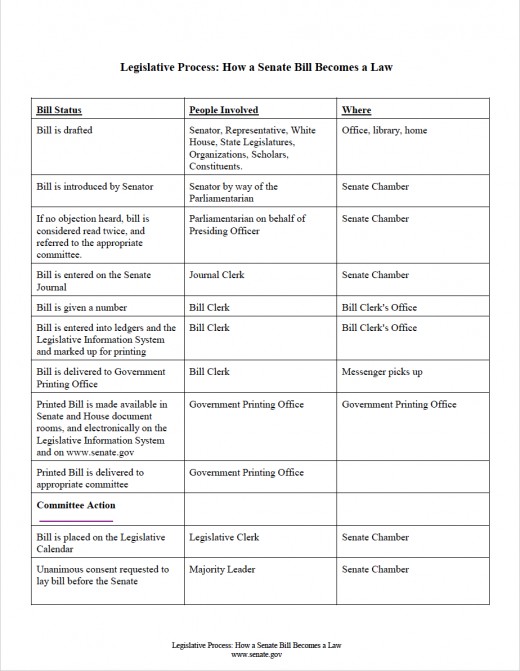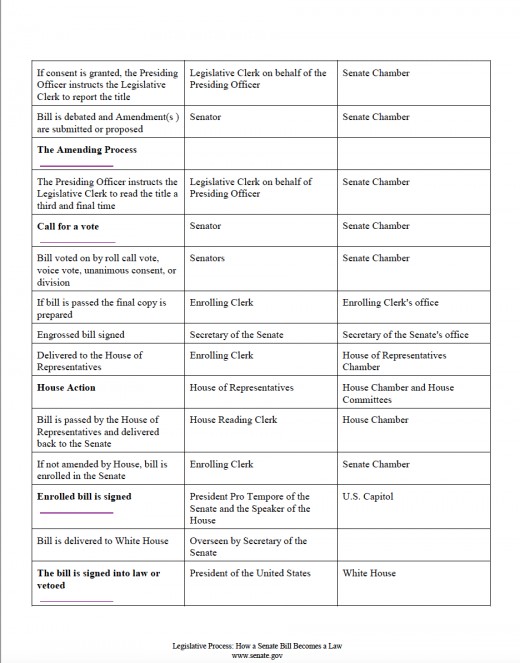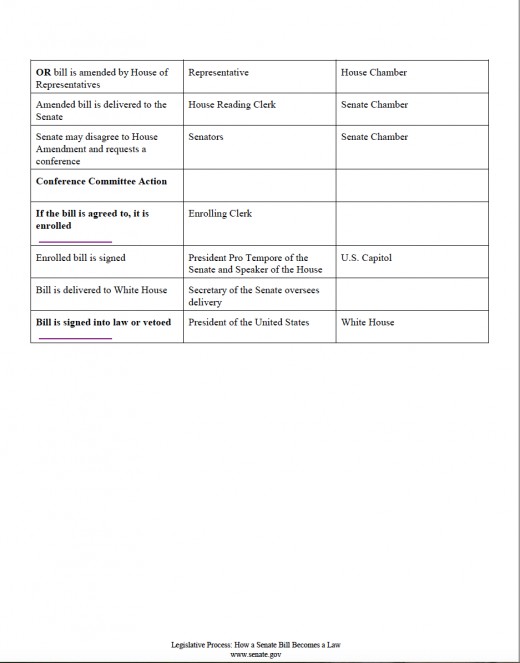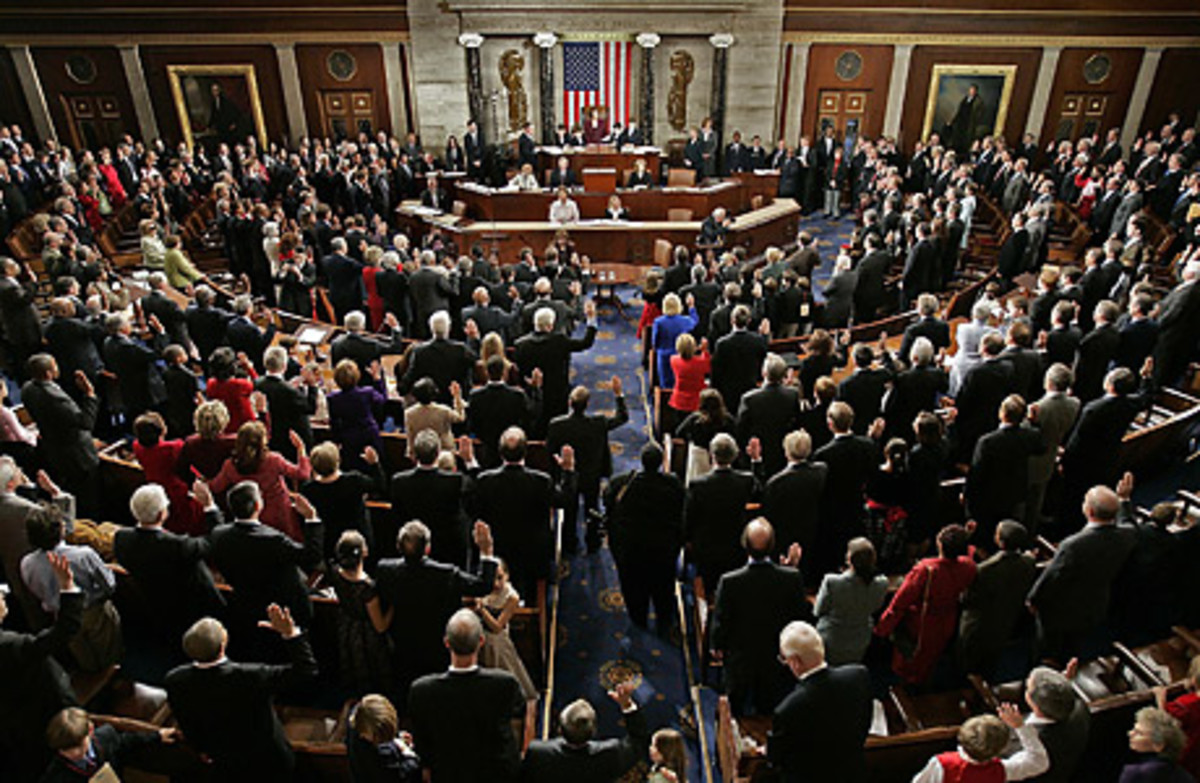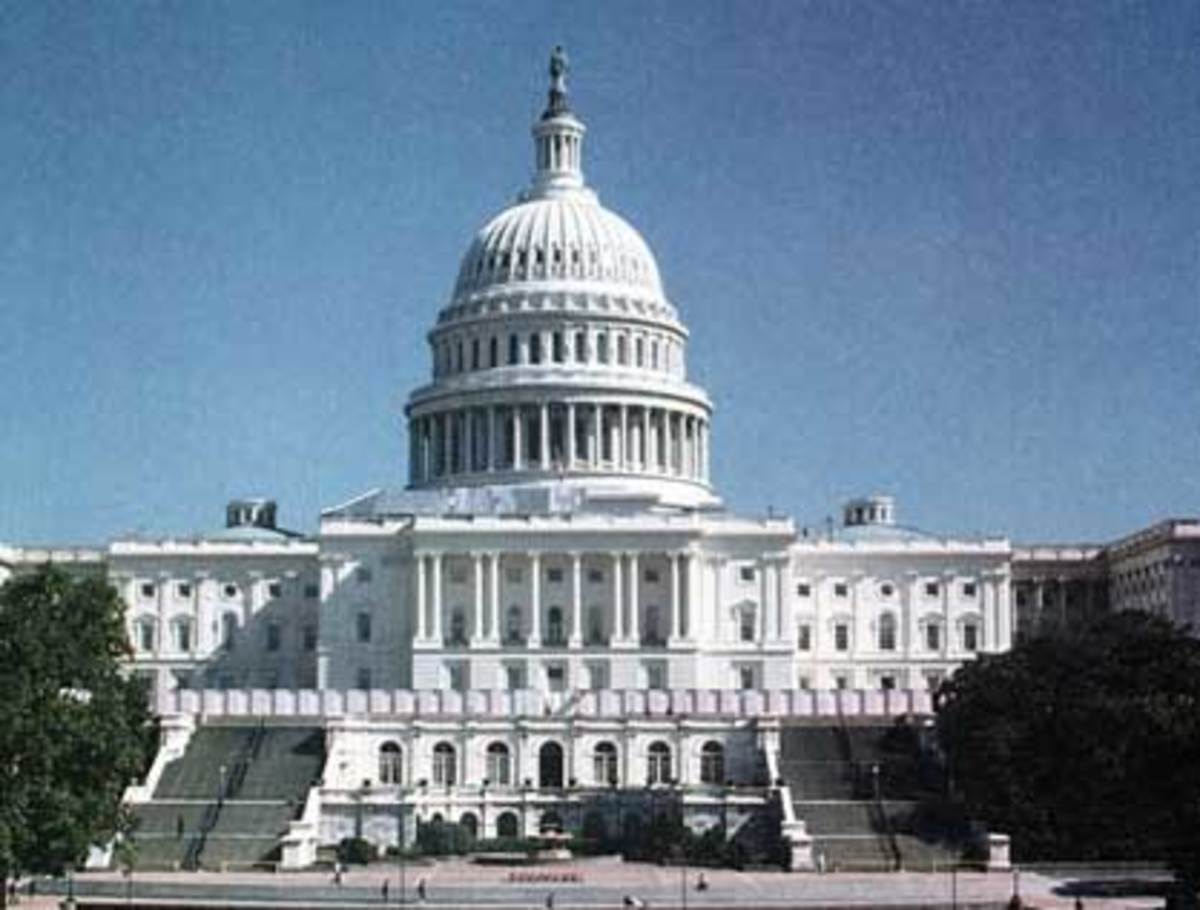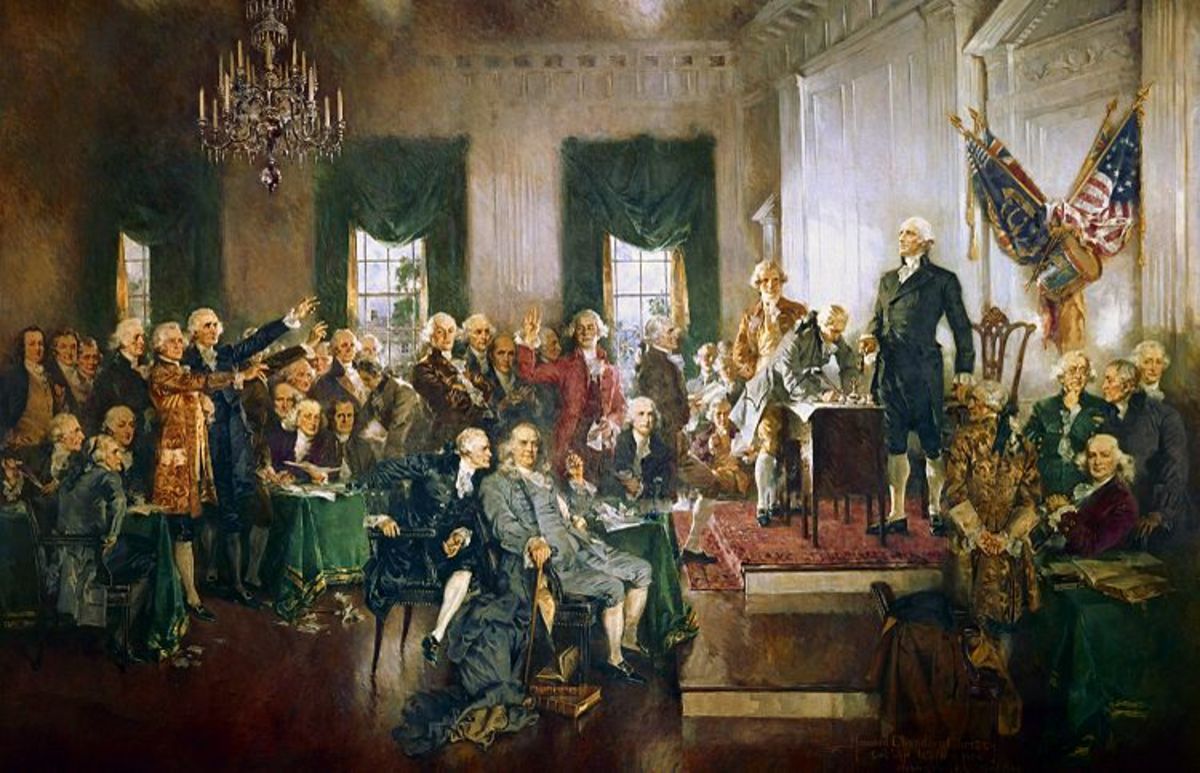How a Law is Made
This article will "briefly" discuss the process of how a bill becomes a law. This article will not discuss the other types of legislation such as joint resolutions, concurrent resolutions, and simple resolutions which pass through Congress. Additionally, this article will not go into detail concerning joint committees, sub-committees, etc.
Supreme Court
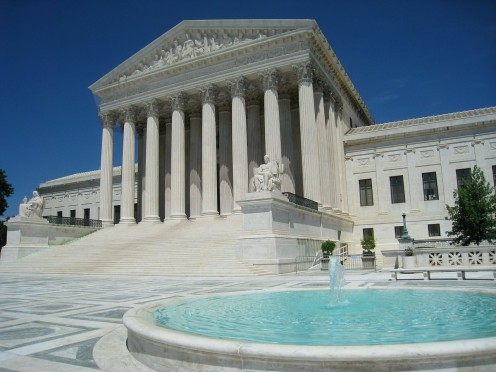
Who has the power to make laws: Per Article I, Section I of the Constitution “All Legislative Powers herein granted shall be vested in a Congress of the United States, which shall consist of a Senate and House of Representatives.” As such, only Congress may create laws. However, the laws created by Congress must pass Constitutional muster (i.e. not violate any other portions of the Constitution.) If a law is passed which seems unconstitutional, a person or entity affected by the law may challenge the law in court. The Judicial Branch of government then has the power to strike down a law, which is unconstitutional if a case is brought before it concerning the legality of a statute. This is part of the checks and balances placed into the Constitution to make sure that any one of the three branches of government does not get too powerful and run afoul of their roles.
What is a bill: Before we can discuss how a bill becomes law, we must first discuss what a bill is and who can present it before congress. A legislative bill is any proposed legislation, which is under consideration by Congress. A bill can only come under consideration by Congress if an elected member of either the Senate or House of Representatives introduces the piece off legislation. However, all bills for raising revenue shall originate in the House of Representatives; but the Senate may propose or concur with Amendments as on other bills. Article I, Section 7 of the Constitution. For any other type of bill presented before Congress either the House of Representatives or the Senate may initiate the legislative bill making process.
A bill will not become law unless it meets all of the legislative and/or executive rules to enact it into law. A bill, which is enacted into law, is called a statute or act. The statute or act, which is passed, may be permanent or temporary. If a statute or act is temporary in nature then it is deemed to have a sunset provision or a date when the law will no longer be a law. However, Congress always has the right to introduce additional legislation to try and extend the temporary laws.
Permanency of the Statute or Act: Statutes or Acts may be permanent, i.e. have no expiry to the effect of the law; or the statute may be temporary. Temporary statutes or acts have what is referred to as a “sunset provision.” A sunset provision is the time a law will remain in effect. After, the date has passed the law will no longer have any effect for subsequent years. However, a law, which has a sunset provision, may be extended by the introduction and passage of new legislation that either extends or makes permanent the law.
Introduction of Bill via the Senate: Bills are introduced by a senator by way of Parliamentarian. This is done by a member gaining the recognition of the presiding officer of the senate (secretary of senate) to announce the introduction of a bill during the morning hour. If any senator objects to the introduction of the bill, then the introduction of the bill is postponed until the next day. If there is no objection to the introduction of the bill then the bill is entered into the Senate journal, given a Senate Bill number, and the bill is entered into the ledgers and the Legislative Information System and marked up for printing. Next the bill is given to the Governmental Printing Office where copies of the bill as produced and made available to the House and Senate document rooms. Additionally, an electronic copy is made available on the Legislative Information System. Once the copy of the legislation if made available to member of Congress, the legislation is referred to a committee according to its subject matter. The Committee may refer the legislation to a subcommittee. The subcommittee may hold hearings, request information, mark up the bill and/or report the legislation to the full committee. The main committee can do all of the same actions with or without consideration of the subcommittee. If the committee is fine with the legislation they can report the bill to the Senate. The committee can also bury the bill.
Introduction of the bill via the House of Representatives: A bill is introduced to the House of Representatives when the bill is placed in the “hopper.” The hopper is a special box located near the speaker’s platform. Once the bill is introduced the bill clerk will assign the bill a number. The bill is then read on the House floor and the assigned to a House committee. Once the bill is assigned to a committee, then bill can be further referred to a subcommittee. The subcommittee can hold hearings on the bill, recommend changes to the bill, vote to accept or reject the bill. If the subcommittee accepts the bill they will refer it back to the main committee. The main committee can also simultaneously review the bill, hold hearings on the bill or take other actions on the bill (including bringing it to a floor vote) separately from the subcommittee. The main committee can also table the bill (withhold it from going to a floor House vote).
What happens when the House of Representatives or the Senate Approves a Bill: If the House of Representatives or the Senate approves their introduced bill, a copy of the bill will then go to the other house to review. A bill must be passed in the same exact language by both he House of Representatives and the Senate before it can go to the President for signing into law. If the Senate and the House of Representatives are far off on what they will accept in the bill then sometimes a joint committee will be formed of Senators and Representatives to try and work on language, which will be agreeable to both houses.
President's Role: If Congress comes to terms on a bill, the bill will then be presented to the president. If the President signs the agreed upon bill then the bill will become law. A bill will also become law if the President does not sign the bill within 10 days (not including Sundays) while Congress is in session. However, if Congress adjourns prior to the 10 day period when the bill is presented to the President and the President does not sign the bill then the boll does not become law. This is known as a "pocket veto."
The President can also veto the bill directly and send the bill back to the chamber of Congress where the bill originated from with notes listing the reasons for the veto. Congress can override the presidential veto if 2/3rds of both houses of Congress supports the bill.
Capitol Building

More on Veto and Line-Item Vetos: A Veto is an act by the President, which signifies he/she does not approve of a proposed piece of legislation, which has been passed by both houses of Congress. The President can signify that he/she is vetoing an bill by returning the bill, unsigned, within 10 days (excluding Sundays), to the House of Representatives or the Senate (whichever house the bill originated from), while Congress is in session. The President must state his/her reservations to the bill in writing. Additionally, the President may do what is referred to as a “pocket veto.” A pocket veto occurs when there are less than 10 days before Congressional adjournment, and if Congress does adjourn before the 10 days have expired where the President may have signed the bill, then the bill will not become law.
Line-Item Veto: A line-item veto is the power of an executive to veto “portions” of a bill while agreeing to the rest of the bill. The Line-Item Veto was deemed unconstitutional by the Supreme Court as a violation of the “Presentment Clause” Article I, Section 7 see Clinton v. City of New York, 524 U.S. 417
How a Senate Bill Becomes A Law
Click thumbnail to view full-size


Conclusion: Hopefully, this article helps you further understand a little more of the process of how a bill becomes a law. Please be on the lookout for future articles concerning how government works.
To learn read more about government and politics, click the articles below:
More about Politics and Government:
- Democratic Superdelegates: This article discusses whether Democrats should make use of Superdelegates during the Democratic Presidential Nomination Process.
- The Process of Choosing an American President: Discusses the process of how an American President is chosen, and what happens if a presidential hopeful does not get the requisite Elector votes to win the Presidency.
- Should everyone, including Felons have the right to vote guaranteed?: A look into why the "right" to vote is not guaranteed to anyone.
© 2016 James

